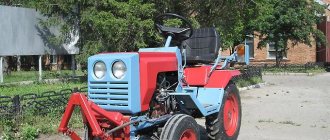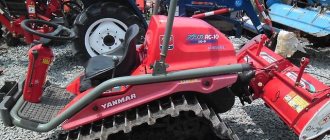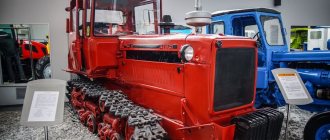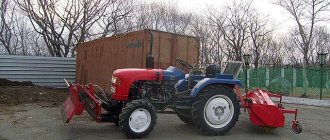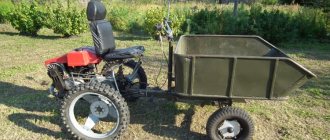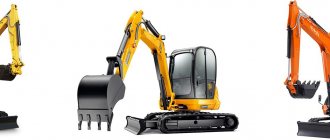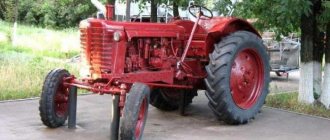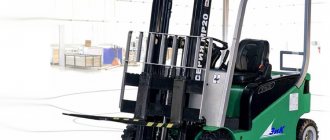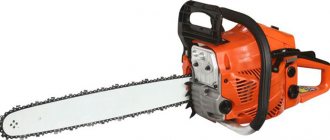Category: TRACTORS
- Construction of tracked vehicles
- Crawler tractors of the USSR
- STZ-NATI
- DT-54
- DT-75
- T-150
- Russian crawler tractors
- Tractor AGROMASH-90TG
- AGROMASH RUSLAN
- Altai 130
- T-501
- Kirovets K744
Wheeled and crawler tractors are used to perform work in industrial, agricultural, mining and other fields. In agriculture, a caterpillar tractor is in demand, as it exerts the least pressure on the soil, due to the large area of contact with the surface. The production of tracked vehicles was developed in the USSR. Today, tracked tractors, unlike wheeled ones, are less popular. Below is an overview of domestically produced tracked vehicles.
Construction of tracked vehicles
The general design of a caterpillar tractor differs from wheeled vehicles in the type of chassis. The leading parts are specialized tracks. This increases the vehicle's maneuverability in difficult areas of rough terrain. The turn is carried out by braking one of the tracks, which allows you to turn the multi-ton vehicle on the spot.
REFERENCE: The main disadvantage of the tracked undercarriage is that it negatively affects the asphalt surface. Therefore, specialized trawls are used to transport equipment.
Other businesses
Of course, the article does not list all the factories that produced tractors in the USSR and continued to operate after its collapse. These are companies such as:
- Altai (Barnaul);
- Onega (Petrozavodsk);
- Uzbek (Tashkent);
- Kirovskoye (St. Petersburg);
- Pavlodarskoe (Kazakhstan).
There are tractor factories in Moscow and in Bryansk, Lipetsk and Kolomna, as well as in other cities.
Since 1991, a new era began in the production of this equipment. If before this period all tractor enterprises belonged to one ministry, now many of them began to be located on the territory of new states. In addition, most factories passed into private hands. I would like to believe that the history of tractor manufacturing in Russia will continue to have a worthy continuation.
STZ-NATI
In 1937, Soviet designers developed the first caterpillar tractor. The development was jointly carried out by engineers from the Stalingrad Tractor Plant and the Scientific Research Tractor Institute. The car was named STZ-NATI.
Compared to foreign analogues, the Soviet caterpillar tractor is more adapted to various climatic conditions and is unpretentious in terms of fuel quality. Compared to wheeled vehicles, it had higher cross-country ability and traction characteristics.
STZ-NATI had a carburetor four-cylinder power plant with a capacity of 52 horsepower. The engine ran on kerosene and was liquid cooled. Water was used to fill the cooling system. The tractor is equipped with a three-way gear transmission. The track links are made of high-strength steel.
INTERESTING: In 1947, the ten thousandth copy of the STZ-NATI tractor was manufactured at the Stalingrad Tractor Plant.
"Universal"
In 1934, production of a new model of tractors began. The first mass-produced Fordson was replaced by the Universal. The model of the Farmol tractor, which was produced by the American tractor, was taken as the basis for its design. In terms of its parameters, it was slightly superior to its predecessor. Its kerosene carburetor engine had a power of 16 kW, an operating weight of 2 tons, and a speed of 8 km/h. The Universal tractor rolled off the assembly line of the Leningrad plant until 1940. After that, its production was moved to Vladimir. Here, at the tractor plant, these units were produced from 1944 to 1955.
DT-54
In the early 50s, the production of the DT-54 tractor began simultaneously at three tractor manufacturing plants of the Soviet Union. The new USSR tracked tractor was created for use in agriculture, and was significantly different from its predecessor STZ-NATI.
The machine has the following characteristics:
- The weight of the equipped car is 5400 kilograms;
- Height from the ground to the top edge of the exhaust pipe – 2300 mm;
- Length with raised linkage – 3660 mm;
- Width – 1865 mm;
- The track size between the tracks is 1435 mm;
- Pressure per square centimeter of earth – 410 g;
- Engine – four-cylinder, four-stroke diesel;
- Power plant power – 54 hp;
- Fuel consumption – 205 g per hp for one hour of operation;
- Cooling system – liquid forced;
- Fuel tank volume – 185 liters;
- The maximum speed is 7.9 km per hour.
The diesel unit is started using a single-cylinder petrol starter. After the main engine starts, the starter switches off automatically. Production of the DT-54 tractor was stopped in 1979.
"Zaporozhets"
These are also the first tractors of the USSR. Their release took place in 1922 at the Red Progress enterprise in Kichkass. However, this model turned out to be imperfect. It had only one drive wheel - the rear one. In addition, the Zaporozhets tractors were equipped with a low-power 8.8 kW engine, which was able to accelerate the “iron horse” to only 3.4 km/h. This tractor had one forward gear and 4.4 kW of power at the hook. Despite such low characteristics, this vehicle was still able to significantly facilitate the work of collective farmers.
DT-75
The DT-75 model is one of the most mass-produced tracked tractors in the USSR. It has been widely used in various climatic conditions, and is distinguished by its unpretentiousness. Over the years, the car has been updated and modified more than once. Depending on the modification, the Soviet DT-75 was used in agricultural, municipal, industrial and other fields.
The basis of the tractor is a rigid frame consisting of two side members and cross beams. The cabin and engine are installed on the frame. To reduce vibration during operation, the power unit is mounted on elastic cushions. The weight of the mechanisms is evenly distributed on the frame, this allows the machine to move smoothly over uneven surfaces.
The tractor chassis includes:
- Balance carriages;
- Drive sprockets;
- Guide wheels (tensioners are installed on the wheels);
- Track rollers;
- Support rollers;
- Two caterpillar tracks.
DT-75, in its basic configuration, is equipped with a four-cylinder diesel engine with an output of 80 horsepower. The power plant is equipped with forced water cooling. Water circulation is ensured by a water pump. Diesel fuel consumption is 250 g/hp. for one hour of work. With a fuel tank volume of 315 liters, fuel consumption allows the machine to be used for a long time without refueling.
The power unit is started by a two-stroke gasoline engine with a power of 10 hp. In the cold season, a pre-heater is installed on the tractor for normal starting.
IMPORTANT: Some modifications are equipped with an SMD-18 engine, which is started by an electric starter.
Stalingrad plant
It was no coincidence that Stalingrad became the city in which the country built its first production facilities from scratch for the production of tractors. The city had a good strategic position, being at the intersection of supply routes for Ural metal, Baku oil and Donbass coal. In addition, there was an entire army of skilled labor in Stalingrad. By the way, according to this indicator, the city has overtaken Taganrog, Kharkov, Voronezh, Zaporozhye and Rostov.
The decision to build a tractor plant in Stalingrad was made by the government in 1925. And five years later, the famous STZ-1 wheel units rolled off the new production line. And after that, the plant produced many wheeled and tracked models. These are USSR tractors such as:
- wheeled SHTZ 15/30 (1930);
- tracked STZ-3 (1937);
- tracked SHTZ-NAITI (1937);
- tracked DT-54 (1949);
- tracked DT-75 (1963);
- tracked DT-175 (1986).
In 2005, the Volgograd Tractor Plant (formerly STZ) was declared bankrupt. VgTZ became the legal successor of the enterprise.
T-150
The T-150 tracked tractor is the best model of Soviet tractor manufacturing. Due to its high technical characteristics, it has been widely used in various fields. The vehicle is distinguished by its speed and cross-country ability.
The basis of the machine is a frame made of two side members and cross beams. The tractor power unit is mounted on the front part of the frame. The engine is mounted on rubber mounts to reduce vibration in the driver's cabin. The rear part of the frame is rigidly connected to the gearbox. A cabin is installed above the gearbox.
The gearbox has four modes:
- Traction (slow);
- Worker;
- Transport;
- Reverse.
There are 4 gears for each mode. Gear shifting is carried out by hydraulic couplings. This allows you to change gears while driving without reducing engine speed. The purpose and general design of the transmission of a caterpillar tractor differs from the wheeled version of the KhTZ. It is possible to select gears separately for each track, thanks to this you can turn the tractor in one place. The gearbox is equipped with a power take-off shaft (PTO), designed to transmit torque to attachments.
The T-150 is equipped with a six-cylinder diesel engine SMD60. The rated power of the power plant is 150 hp. The engine has a V-shaped cylinder arrangement and mixed (water-oil) cooling. Combined engine start. The electric starter starts the gasoline starter, which powers the main power unit. In the cold season, a pre-heater is provided to make starting easier.
Wheel models
Among the most popular and sought-after models of Soviet equipment of this type are wheeled devices. They are characterized by fast movement speed, allowing the equipment to independently reach the work site. Such devices are universal and suitable for most tasks.
Kolomenets-1
The first tractor in the USSR was Kolomenets, whose production started in 1923 and continued for 6 years. This model is an exact copy of the popular American Mogul tractor, however, some components present in the original were missing.
This made it possible to achieve greater speed of movement, which was especially important when it was necessary to move impressive distances. Among the characteristic features of Kolomenets it is advisable to include a frame frame, as well as a power unit with a capacity of 25 hp . It worked on a two-stroke principle and had 1 cylinder.
Tractor Kolomenets
Zaporozhets
Another old tractor produced during the Soviet era is the Zaporozhets. Its manufacturer, the Red Progress concern, began mass production of the model, almost simultaneously with Koloments. The new unit was distinguished by its low weight and affordable cost, which was due to the use of budget materials in the design.
It should be mentioned that the power unit of this vehicle ran on crude oil. Unlike most analogues, the model is three-wheeled, which makes its design non-standard and memorable.
Zaporozhets tractor model
Dwarf
The creator of another popular Soviet tractor, the Karlik, was the inventor Y. V. Mamin. He developed two new models at once - Gnome and Dwarf, which differed from numerous foreign analogues in their low weight, as well as high maneuverability, allowing them to carry out work even in cramped conditions.
Be sure to read: Tractor K 701 Kirovets
A characteristic feature of this tractor is its sufficient traction power, suitable for most tasks, and its ease of assembly and repair has made it incredibly popular.
Tractor Dwarf
Fordson-Putilovets
Another prominent representative of USSR tractor technology is Putilovets, produced in 1922. It was designed on the basis of its American counterpart, Fordson, but its design was adapted for domestic operating conditions.
Thanks to the changes made, the engineers managed to create an effective and promising model, which became the basis for most wheel-type units. The product was equipped with 4 wheels, 2 of which are driving, as well as a 4-cylinder engine, the power of which reached 20 hp.
Fordson-Putilovets
Station wagon
Somewhat later, at the plant in St. Petersburg, mass production of Universal series tractors was launched, which differed from all other analogues in their increased power. Several modifications were released at once, each of which was designed to solve specific problems. U-1 was used for processing crops with tall stems, U-2 for short ones, and U-3 was used for cultivating the soil between rows. For cotton harvesting, the designers specially developed another modification of the U-4, which made the model universal. Subsequently, the production of the tractor was expanded; it began to be produced not only in St. Petersburg, but also in Vladimir.
Tractor Universal
T-150
A real breakthrough for tractor manufacturing in the USSR was the T-150, which significantly exceeded all existing analogues in power and speed. Its power reached 170 hp, and the ground clearance was 40 cm, which allowed it to easily move off-road.
Tractor T 150
AGROMASH RUSLAN
The Ruslan model was released in 2008. The tractor has high performance. The machine performs a wide range of work in agriculture without damaging the fertile soil layers.
A distinctive feature of the Ruslan model is the chassis. The tracks are mounted on triangular guides. This makes it possible to obtain high traction force. The tracks are made of reinforced rubber. This material allows the tractor to move smoothly on different surfaces without damaging them.
"Ruslan" is equipped with a six-cylinder diesel engine. The power of the power plant is 340 hp. The engine is equipped with a turbocharger with forced cooling of the charge air. Liquid cooling system. Diesel fuel consumption is 227 g per kW per hour of operation. The engine complies with European standards.
"Ruslan" has a hydromechanical gearbox. Number of gears – 16 forward and 3 reverse. Gear shifting is possible on the go without reducing engine speed or loss of power.
The car has a modern cabin equipped with an air conditioning and heating system. The cabin is sealed. This prevents dust and harmful substances from entering the interior. Panoramic glazing improves operator visibility while working. An air-sprung tractor driver's seat is installed in the cabin. The controls allow you to adjust the seat for a person of any size.
Altai 130
Altai 130 belongs to the modern crawler tractors produced in Altai. The machine belongs to traction class 4, and performs work in agriculture using attachments.
The main difference between the Altai 130 tractor is its comfortable cabin. The tractor is controlled by a steering wheel instead of levers. The tractor driver's seat has an ergonomic backrest and armrests. The cabin is sealed and equipped with air conditioning, autonomous heater, and audio system. The controls are located in close proximity to the operator's seat.
The car is equipped with a six-cylinder diesel power unit with turbocharging. The volume of the power plant is 16.75 liters. Diesel unit power – 140 hp. It is sufficient for the intended use of the tractor with various equipment. Altai 130 fuel consumption is 245 g/kW per hour of operation.
"Dwarf"
The inventor Mamin did not retreat from his work either. He went down in history by producing tractors in Russia and the USSR. After improving his own pre-revolutionary design, Mamin became the project manager for the creation of tractors of the “Karlik” family.
Their production began in 1924. Thus, agriculture received three-wheeled tractors “Karlik-1”, equipped with one gear. Their speed reached 3-4 km/hour. The Karlik-2 tractors, equipped with reverse, were also produced.
T-501
Russian-made tracked agricultural tractor. The T-501 is the most powerful vehicle in the model range produced. The largest crawler tractor can handle semi-mounted and mounted agricultural implements.
The car is equipped with a six-cylinder turbocharged diesel engine producing 280 hp. and has the following technical characteristics:
- Length with attachment installed in transport position – 6200 mm;
- Width – 2250 mm;
- Height – 3200 mm;
- Track base – 2100 mm;
- The track in the center of the tracks is 1720 mm;
- Ground clearance – 450 mm;
- The mass of the equipped vehicle without attachments is 11,400 kg;
- Surface pressure 0.45 kgf per cm2;
- Gearbox – mechanical;
- Number of gears (forward, reverse) – 8, 4;
- Diesel fuel consumption – 164 g per hp. for one hour of work.
The T-501 has high maneuverability in difficult areas of rough and swampy terrain, and good traction characteristics. This allows you to cultivate soil with varying degrees of moisture. Retaining moisture in the soil in early spring contributes to a good harvest.
Kirovets K744
The model is produced at the St. Petersburg Tractor Plant. The basic modification is made on wheels with low-pressure tires. Additionally, it is possible to replace the wheels with specialized tracked modules. The tracks of the K744 tractor are made of reinforced rubber, thanks to which the machine can move on asphalt surfaces without damaging it.
Kirovets K744 has 4 modifications, the main difference of which is the power of the power plant. The manufacturer installs an automated gearbox with leverless control on the tractor. Switching is carried out by the joystick and the buttons located on it. The gearbox has 16 forward gears and 8 reverse gears.
The tractor cabin is distinguished by a high degree of comfort and functionality. An on-board computer is installed in the K 744 cockpit. It informs the operator about the operation of all systems and mechanisms. The controls are located in close proximity to the operator's seat. This arrangement allows the tractor driver to easily operate a multi-ton machine. T744 has proven itself well when performing any type of agricultural work in various climatic conditions.
From the above it follows that since the times of the Soviet Union, the domestic tractor industry has been developing. Regardless of the fact that tracked vehicles are less in demand than wheeled vehicles, they are constantly being modernized, and in many technical indicators they are not inferior to foreign analogues of the corresponding class.
Soviet tractor industry
The peaceful Soviet tractor made it possible to perform many tasks and significantly increased the efficiency of collective farms, which made it one of the most important elements of economic activity. Despite the modest power indicators characteristic of most models, they were able to significantly increase productivity and help in performing labor-intensive work.
The first models of tractors in the USSR began to be produced in 1923; they were universal machines designed to solve a wide range of tasks. The emergence of such technology was one of the reasons for the state's success in the economy during the first years of its existence, since the national economy at that time was in decline. Among the main works that were carried out using this type of units, it is advisable to include:
- plowing fields;
- towing cargo, especially at logging enterprises;
- laying roads, erecting houses and other structures;
- work in the public utilities sector.
The USSR had a developed tractor industry
Early models were domestic analogues of foreign developments, most often American tractor equipment. Engineers often made various changes to the design of devices that affected the performance of the tractor.
Tractor factories
The history of tractors in the USSR is closely connected with the enterprises where they were produced, since for most of them the production of such equipment became a priority activity. The idea of creating enterprises specializing exclusively in the production of tractors belongs to F.E. Dzerzhinsky. She found support from the government, which led to the emergence of many inexpensive and reliable units that were adapted to difficult operating conditions.
Be sure to read: Tractor MTZ 952
The largest manufacturing enterprises were located in the following cities:
- Stalingrad;
- Kharkiv;
- Minsk;
- Chelyabinsk.
These factories were the largest, but many other enterprises were located throughout the country, for example, in St. Petersburg, Petrozavodsk, Tashkent and other cities.
